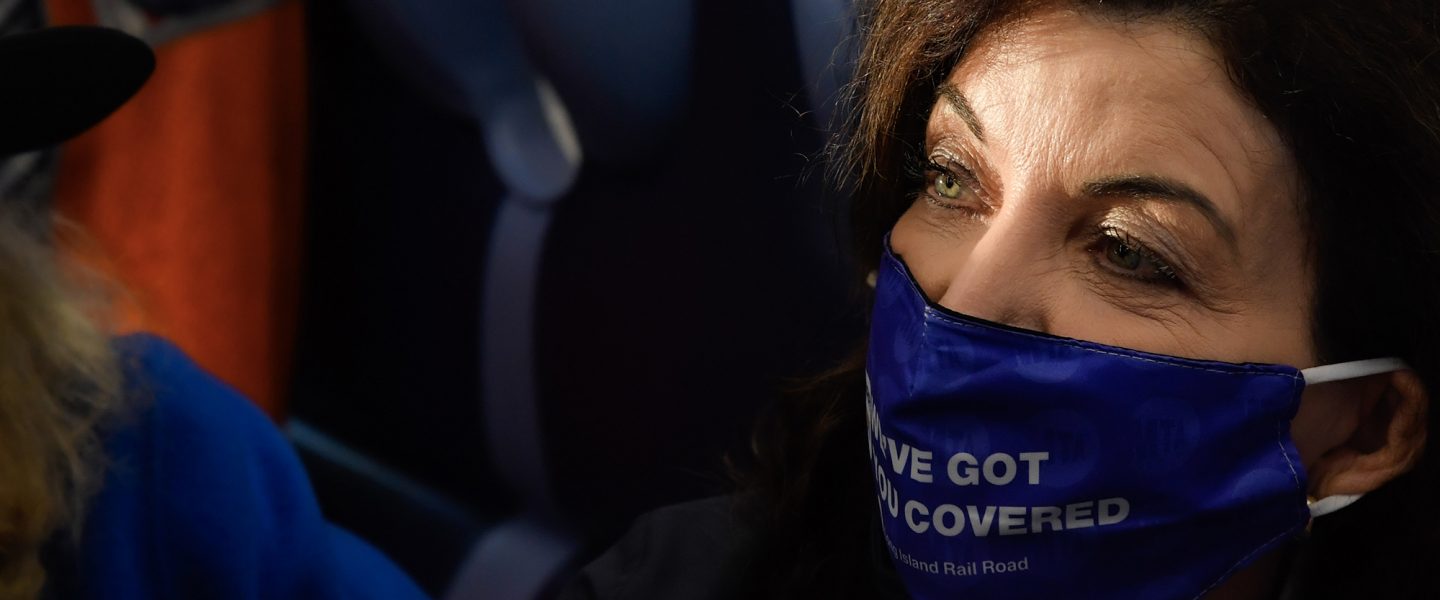New York Democrats preferred an environment that precluded progressive victories even at the cost of a catastrophic loss for the national party.
|
Listen To This Story
|
Kathy Hochul, the Democratic governor of New York, nominated an anti-choice, anti-union judge, Hector LaSalle, to the top judicial position in the state: chief judge of the NY Court of Appeals. That’s a pretty strange nomination in a state that has a Democratic supermajority in the state Senate, negating the notion that a compromise pick would be necessary for confirmation. Why, then, is a Democratic governor in a very blue state trying to govern from the right?
The answer starts with looking at the most dominant figure in New York politics over the last two decades: former Governor Andrew Cuomo. Hochul, a loyal political wingman to Cuomo in addition to being his lieutenant governor, took over after Cuomo resigned amid myriad scandals and accusations, including sexual harassment and mishandling of the state’s response to the COVID-19 pandemic. Her loyalty to and alliance with Cuomo matters because of his legacy of antagonism to the Left, perhaps most notable in his judicial appointments.
Cuomo appointed four conservative judges to New York’s highest court, two Republicans and two conservative Democrats, a bloc that constituted a majority on the seven-member court and voted together 96 out of 98 times. Cuomo also put a cap on property taxes and tightened limits on spending. Common Cause described the former governor as having done “many things which basically advantaged Republicans and disadvantaged particularly the more progressive aspect of the Democratic Party in order to retain his own power.”
To understand Cuomo’s willingness to lean right, a clue might be that, as a member of Bill Clinton’s cabinet (secretary of Housing and Urban Development from 1997 to 2001), he was a firsthand witness to triangulation, the Clinton policy of moving the Democratic Party in a rightward and business-friendly direction.
Cuomo’s particular resentment of the New York Democratic Party might have come from a slight from the party when he lost his bid for the Democratic gubernatorial nomination in 2002. At that time, fresh from Clinton’s cabinet, he assumed the party would support him, but the establishment instead supported Comptroller Carl McCall. Cuomo’s campaign disintegrated and he dropped out before the primary.
Cuomo wasn’t elected governor until 2010, after serving as New York’s attorney general. Then, when he sought reelection, he was challenged for the office from the left by Zephyr Teachout in 2014 and Cynthia Nixon in 2018. To defeat Nixon, Cuomo raised a great deal of money from power players in the real estate and health care industries. This is something of a chicken or egg situation: Did his rightward governing serve to snag donations from the power players or did his need for money in 2018 push him (and the governance of New York) further in a conservative direction?
Integral to the scandals that took him down was the perception that Cuomo was returning favors to his donors by enacting policies that forced nursing homes to accept patients with COVID-19, at great risk to the other patients and medical providers. Again it was unclear whether he was paying back old favors or just believed the government should protect the power-player industries in a time of crisis.
But it’s not just Cuomo or his political lieutenant Hochul who have come out in favor of an anti-union, anti-choice chief judge. The current Democratic leader in the US House, Hakeem Jefferies, who represents a New York district, attended a rally to support the nomination.
Jeffries is, like Cuomo, something of a Clintonesque triangulator, leaning leftward on social issues but right of traditional Democrats on economic issues. He identifies as a progressive, but mainly in fighting for racial and social justice. He alienated his fellow progressive caucus members by not signing on to the Green New Deal and by founding a PAC to protect incumbents from challenges, a policy that generally benefits establishment (i.e., more conservative) Democrats and impairs progressive challengers.
Such Democratic politicians who would support an anti-choice and anti-union judge certainly demonstrate a rightward lean but how is that a national issue or damaging to the state and national Democratic parties? The answer resides in the decade-long battle regarding gerrymandering and the drawing of electoral maps in New York.
 The Legislature, with Democratic supermajorities in both chambers, having gained their Senate supermajority in 2020, aimed to draw a Democrat-friendly map, or at least a fairer map than the previous one that strongly favored Republicans. Such redistricting for partisan advantage was, after all, standard operating procedure in states under full Republican control.
The Legislature, with Democratic supermajorities in both chambers, having gained their Senate supermajority in 2020, aimed to draw a Democrat-friendly map, or at least a fairer map than the previous one that strongly favored Republicans. Such redistricting for partisan advantage was, after all, standard operating procedure in states under full Republican control.
Approved by the Legislature, the map was thrown out by the New York high court, with its aforementioned conservative majority, appointed and championed by Democrat Cuomo. And thus, when the 2022 election came, several of New York’s key Democratic US House candidates faced uphill battles, suffered losses, and the Democratic Party consequently lost the House.
There is a complicated but causal thread running from the appointment of these conservative judges to the loss of Democratic national power. Ironically, New York’s overwhelming Democratic tilt likely contributes to its ruling party’s internal schism. If the Republican Party is unlikely, as a brand, to win statewide elections, it makes more sense for pro-business donors to spend their money backing business-friendly Democrats than the relatively powerless Republican opposition.
Consider, analogously, that when Republicans were unelectable in the South for close to a century, it didn’t stop the South from producing archly conservative politicians. Strom Thurmond, a Republican icon of conservatism and opposition to civil rights, originally ran for the Senate as a Democrat and won in 1954.
While motive is not always easy to ascribe, the New York Democratic leadership made decisions time and again to move rightward and spite progressives — decisions that led ultimately to a huge defeat in the state’s redistricting process, a defeat having decisive national impact.
It is unlikely the leadership made these decisions in blissful ignorance of the consequences of their action. Logically, it follows that it is possible that the New York Democrats preferred an environment that precluded progressive victories even at the cost of a catastrophic loss for the national party — and, it may well turn out, for the nation.
Doug Ecks is a lawyer and writer. He graduated from UC Hastings in 2010 magna cum laude with a JD and Phi Beta Kappa from CSULB with a degree in philosophy. He also writes and performs comedy as Doug X.




